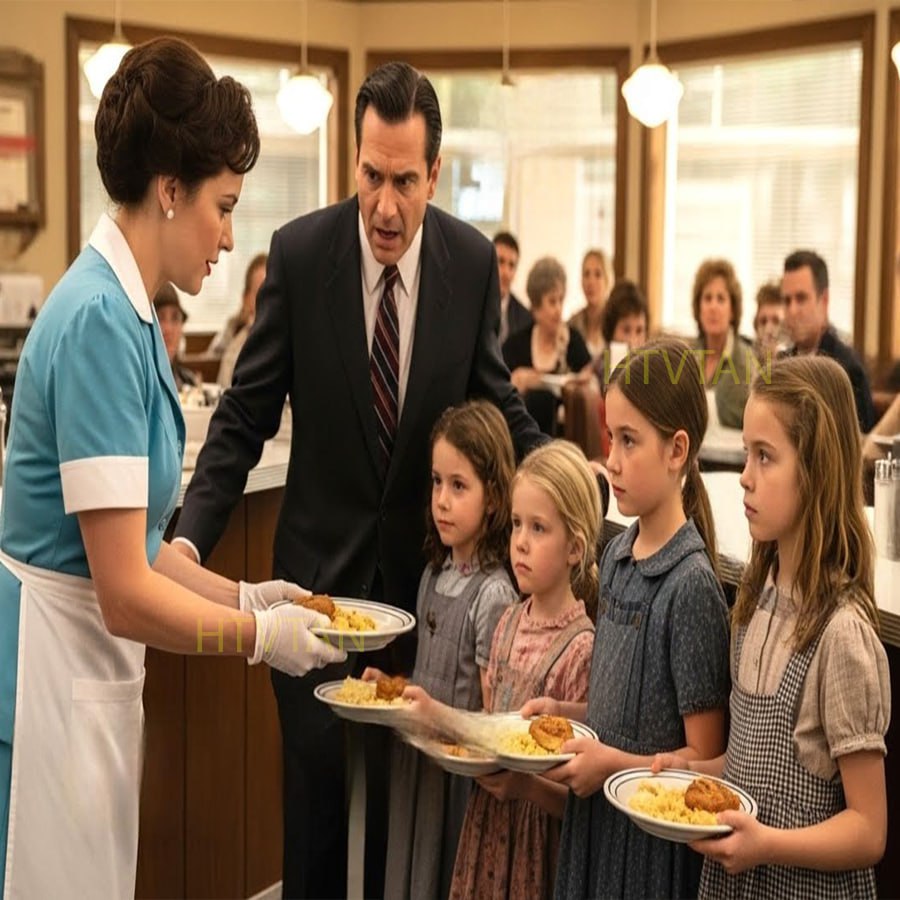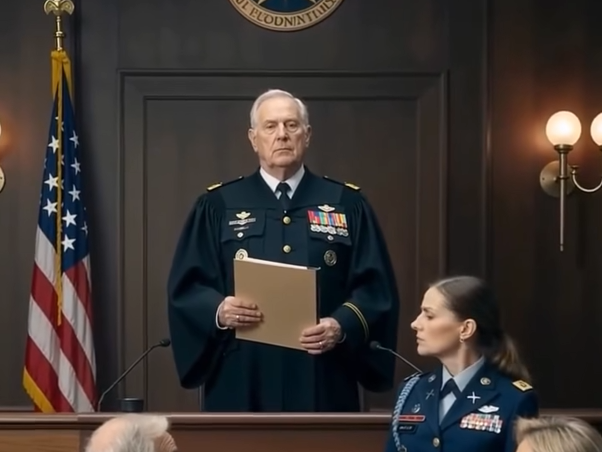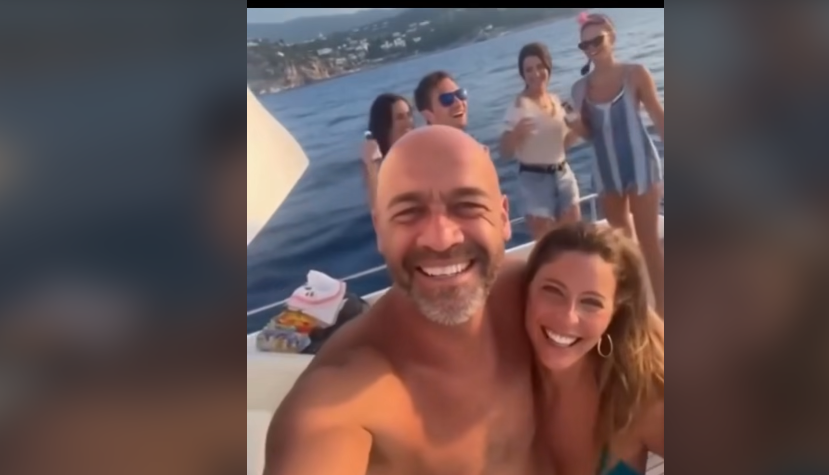It was a cold, rainy night in a quiet town when Emily Parker, a young waitress at a small roadside diner, noticed four little girls huddled together outside her window. Their clothes were torn, their hair wet, their faces pale from hunger and fear. They couldn’t have been older than ten, the youngest barely six. Emily’s heart ached.
She stepped outside, umbrella in hand, and crouched down. “Are you girls okay?” she asked gently. The oldest one shook her head but said nothing. They were shivering too hard to speak. Without another thought, Emily led them inside and sat them at a corner booth. She brought them hot soup, sandwiches, and cocoa—on the house.
That night, she learned their story. Their parents had died in a fire months earlier. They’d been in and out of temporary shelters, separated more than once, and had finally run away together to avoid being split apart again. No family. No home. Just each other.
Emily didn’t have much herself—she lived in a tiny rented house, worked double shifts, and sometimes skipped dinner to make rent. But when she watched those girls devour their food like they hadn’t eaten in days, she made a decision that would define the next decade of her life.
From that night on, Emily became their guardian angel. She brought them leftovers from the diner, saved part of her tips to buy food and clothes, and eventually helped enroll them in school. When homework confused them, they came to her little kitchen table, and she taught them what she could. When nightmares woke them, she was there with warm blankets and soft lullabies.
For ten long years, Emily stood by those four girls. She had no legal obligation, no financial stability, and no partner to share the load. Yet she gave them everything—time, care, and love.
The townspeople talked. They said she was a fool, wasting her life on children that weren’t her own. Some accused her of doing it for attention. Others pitied her. But Emily didn’t care. She wasn’t raising them for approval. She was doing it because no one else would.
Every milestone became her reward: the first time the girls called her “Mama Emily,” the first report card with straight A’s, the day they got accepted into a proper high school. She worked until her feet ached and her back screamed, but every smile they gave her made it bearable.
Years passed. The girls grew into young women, strong and confident. They studied hard, worked part-time jobs, and promised Emily they’d make her proud. And then, one by one, they left for college, all on scholarships they’d earned themselves.
The house was quiet after they were gone. Emily still woke up early, brewed her tea, and sat by the window waiting for their occasional calls. She missed their laughter, the chaos, the noise—but she was happy knowing they had a future.
Time moved on. Twelve years passed since that rainy night outside the diner. Emily had grown older; her hands ached from years of hard work, her hair had silver strands, and her little house was more worn than ever. But she still smiled when she thought of her girls.
One gray afternoon, she sat sipping tea on her porch when she heard a deep rumble in the distance. It grew louder until a sleek black SUV turned the corner and stopped right in front of her home. The kind of car no one ever saw in that poor neighborhood.
Her heart jumped. She froze, clutching her teacup. The driver stepped out—a tall man in a suit—and opened the back doors. Four young women stepped out, dressed sharply, polished, radiant. For a second, Emily didn’t recognize them. Then her breath caught. The curve of a smile, the glint in the eyes, the same familiar warmth—it was them.
Her girls.
“Mama Emily!” one of them shouted, tears already spilling as they ran toward her.
Emily’s cup fell and shattered. Before she could rise, all four of them were around her, hugging her tight, laughing and crying all at once. She felt their arms around her, their warmth, their love—and it hit her like a tidal wave. They weren’t children anymore, but they were still hers.
She sobbed into their shoulders. “Look at you. My beautiful girls. What have you become?”
One of them pulled back, eyes shining. “Everything we are, Mama Emily, is because of you.”
Another reached into her purse and placed a small silver key in Emily’s trembling hand. “This is yours.”
Emily blinked, confused. “What is this?”
The girl pointed toward the SUV. “That car—it’s yours now.”
Emily’s jaw fell open. “Oh no, girls, I can’t—”
But one interrupted softly. “You can, and you will. It’s only the beginning.”
Another smiled through her tears. “We’ve also bought you a house, Mama Emily. A real one. You’ll never have to worry about bills or rent again. We promised ourselves that one day we’d give you the life you gave us.”
Emily’s knees gave out. The girls caught her before she fell. Tears streamed down her face as she whispered, “I never expected anything from you. I just wanted you to have a chance.”
“And you gave us that chance,” said the eldest. “You gave us love when no one else did. You gave us hope when we had none. You were the mother we prayed for.”
They helped her into the SUV, and as it rolled through town, neighbors peeked out their windows—the same ones who once mocked her for wasting her life. Now they stared in stunned silence as the black car carried Emily away.
They arrived at a beautiful home in a quiet neighborhood, surrounded by flowers and sunlight. The girls led her to the front door. The moment she stepped inside, she gasped. The walls were painted her favorite shade of blue. The shelves were filled with books she loved. On the kitchen counter sat a small plaque engraved with the words: Welcome Home, Mama Emily.
“Is this really mine?” she whispered.
“It’s all yours,” one of them said. “You’ve spent your whole life giving. Now it’s our turn.”
Emily covered her face, crying harder than she had in years. The girls wrapped their arms around her again, and for a long moment, none of them spoke.
She remembered all the nights she’d gone hungry so they could eat, the second-hand clothes she’d stitched by candlelight, the laughter around her worn-out kitchen table. Every hardship, every tear—it had all led here.
When she finally found her voice, she said softly, “I don’t deserve this.”
The youngest took her hand. “You deserve the world, Mama Emily.”
As the sun set behind her new home, Emily stood on the porch surrounded by the four women she’d raised, her heart overflowing. The life she’d once thought lonely was now full beyond measure.
“God answered my prayers,” she whispered. “He gave me daughters and He gave me a family.”
That night, for the first time in years, Emily slept without worry—no debt, no exhaustion, no fear of tomorrow. Just peace, love, and the sound of rain outside her window, like the night her life changed forever.
Her story became a quiet legend in the town—a reminder that kindness, no matter how small, never fades. It grows, it blooms, and one day, it finds its way back home.









